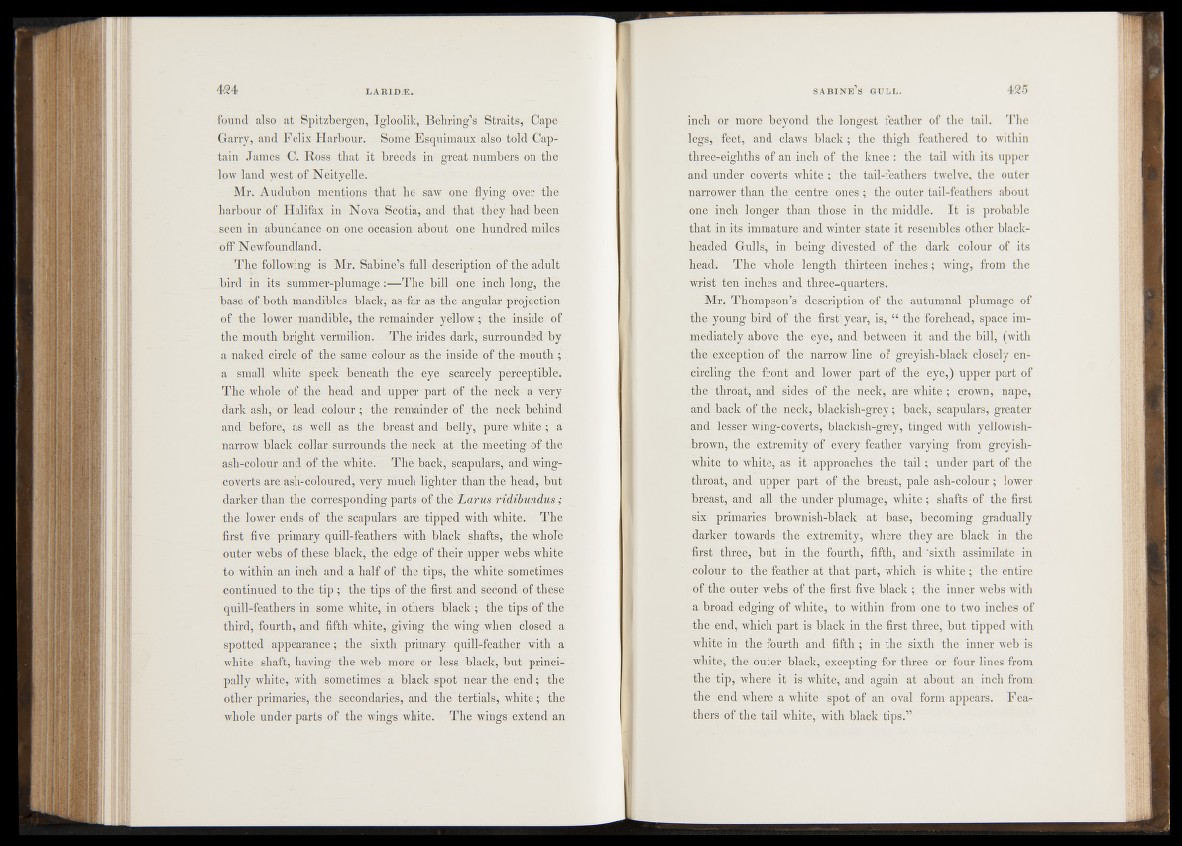
found also at Spitzbergen, Igloolik, Behring’s Straits, • Cape
Garry, and Felix Harbour. Some Esquimaux also told Captain
James C. Ross that it, breeds in great numbers .on-the'
low-land west of Neltyelles^,
Mr. Audubon mentions that he saw one flying- ovpr the
harbour of Halifax in Nova Scotia; and that -they had been
_s©en in^abjiindance on one occasion about one hundred mile's
b ff Newfoundland.
The following is Mr. Sabine’s full; description of the adult
Jbird- in .its summer^plumage —The bill fend inch long, the
base of both'mandibles.-black, as far as the angular projection
of the lower mandible, thh-remainder-^iiilbw; -the inside; of
the mouth bright vermilion. The irides dark, surrounded by
a naked-eirtlg of the sameuxflour as the inside of tlieunduMiV
a small white speck beneath- the;, eye-f-scar©ely perceptible*
The whole—of the head and-upper part- dfrfhedhbeh^^.veily
dark ash,>or lead^ colour ; the remainder >d£;<thet"neck behind
and before,“.as well as the breast and -belly, pure v |h ij||| a
narrow black collar surrounds the*neck at the-ihe^tMg-of tfefl
ash-cotehr and of the white'; - The back,*scapularsj and wing-
coverts are ash-coloured, very much-lighter than*the head, b u t
darker than the corresponding parts - ©fthe/£ar ms. T i d i b u n d u s f
the lower ends of the’^scapufers -are tipped with whited The
first five primary quill-feathers with black shafts, the,whole
outer webs of these black, the edge of their,upper webs white
to Within an inch andj adialfrof the tips, the'whife sometiiies
continuedIteithe tip ; the tips of the first iind-second^pf^th^d
quilhfeathers in some white, in'others black ; the'1- taps- <|ME©
third, fourth, and fiffeh"white, giying-fhe wing when;closed^ar
spotted appearance; thd^sixth primary- quill-feather '’with a
white shaft, having the web m order less black, but principally
white, with sometimes a black bpot near the end ;- the
other primaries,- the. secondaries, and the- tertials, white; the
whole under partsjgiHhe wings white;'1 The wings-?0x't0nd/au
inch or more beyond the longest feather of the tail. The
legs, , feet, and claws black; the thigh feathered to within
ihtfee-eighthsfof an inch of the knee : the tail with its upper
and under* e v erts whitd’: the tail-feathers twelve, the outer
narrower than tlm centre ones ; the outer tail-feathers about
-inch longer than; thosë^in the middle. I t is probable
that*in its immature and winter state it resembles other black-
feaded Gulls', in being- divested of the dark colour of its
head-. The "whole length 'thirteen inches; wing, from the
wrist ten inches and three-quarters-;
Mr. Thotópsön’s” descripfrcuï^'^the autumnal plumage of
thèAbung bird of- the first‘i year, is, “ the" forehead, space immediately
above ..the eye, and between it and the bill, (with
thfe;exöeptrónbff thefenarrow line «f^greyish-black closely.en-
cjrcling fthd-front - and lower part of the eye,) upper part of
^he-throat^and sides of the neck, are white; crown, nape,
and* back of the neck,- blackishfgfjy; back,' scapulars, greater
and lef^gwing-^^^&rtlf-bladkisl|^;rey, tinged with yellowish-
Jtoown, the extremif^of e ltw frathdf^varying from greyish-
white to white, as it approachÊp the ta il; under part of the
throat, and upper part of thé breast, pale ash-colour; lower
bre&st, and all the under plumage,, white; shafts of the first
sixl< primaries- brownish-black at base, becoming gradually
da-rkërJ&towards thè^dxfcremity, where they are black in the
first three, but* in the fourth, fifth, and "sixth assimilate in
/colour to thé* feather at that'part, which is white; the entire
of the outer websipf the first five black ;* the inner webs with
a broad edging of whiter to within from one to two inches of
the end, which part is black in the first three, but tipped with
WKOTn the fourth and fifth; in the sixth the inner web is
white, the Outer1 black, ‘’excepting for three or four lines from
the tip/ whérê' it is white, and again at about an inch from
the end where*-a white spot of an oval form appears. Feathers*
of theHail white, with black tips.’*1 w